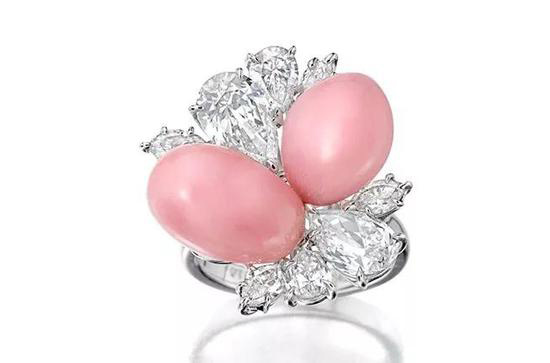Everyone knows pearls, their luster and beauty give jewels classic and timeless.
But ordinary pearls can never meet the requirements of gemstone connoisseurs, and another unique mollusc breeds pink pearls. In the Caribbean, conch beads are naturally produced in the Queen's phoenix snails, most of which are elongated or irregularly baroque in shape, and are almost circular in shape.
During the Victorian period, they were organized by Cameo's embossed materials, and during the period of Edward's reign, they were also used to create jewels in the Art Nouveau period. They were popular until the Art Deco period, and after a short bid farewell to the historical stage, they returned in the 70s and 80s. This is thanks to American professional diver Sue Hendrickson, who acquired shells in the Caribbean and has a collection of high-quality pearls that reproduce their glory as jewelry design materials.
Today, this pink-toned pearl includes Mikmoto, Tiffany & Co. Well-known brands such as Harry Winston, Chopard and Hemmerle have appeared.

Snail beads
Conch is a kind of calcareous tuberculosis of the spiral shell of a large sea snail. They have the structure of a pearl, but like the Melaleuca, it is not a true bead.
They are heavier than oyster pearls, differing in size by carat weight and diameter, harder and more resistant to erosion. The chemical composition of conch beads and pearls is the same, but the conch group is polycrystalline.
The best quality flame pattern is visible to the naked eye
Because of the calcium microstructure formed in concentric circles, this lamination tends to create a flame-like appearance.
The most coveted is the visible structure of the flame, and in fact, the "vigor" value of the flame is an important factor in determining the value of the conch, and other factors include shape and size.
Conch beads are also rich in body color, from pink to white to brown, pink is the most common. According to SonnySethi of TaraPearls, "baby powder" is the most popular of all colors in Conch.
Conch beads are extremely rare
Conch beads can only grow naturally and cannot be artificially cultivated. A conch bead can be found in every 10,000 to 20,000 shells. The gem-class can only see one per 100,000 shells.
According to the US Fish and Wildlife Service, the Queen's phoenix snail grows in relatively shallow waters and grows slowly, prone to overfishing. They are also threatened by overfishing: once in the Florida Keys, but in the 1970s the conch fishery was on the verge of collapse, and now any fishing on this species is illegal. However, according to the "Convention on International Trade in Endangered Species", the Queen's snail is slowly recovering.
In 2009, the Institute of Oceanography at Florida Atlantic University in Bay Harbor developed a patented farming technology. In two years, researchers Héctor Acosta-Salmón and Megan Davis have cultivated 200 cultured conch beads. The author contacted the school's research institute, but since then there has been no progress and additional information.
Stable national demand
Due to the uniqueness of the conch beads, white conch beads are also in demand. This is not surprising, as they are rare and expensive, and can only be contacted by specific customers.
Seven or eight years ago, the white conch beads began to enter the market, and the demand has been stable. “The demand is there, but only at the elite level. This means that Conch beads can only be sold in boutiques and in-depth jewelry stores. ."
Mens Pu Jacket,Men Winter Pu Leather Jacket,Hooded Men'S Pu Jackets,Men Baseball Pu Jackets
Shaoxing Moonten Trade Co., Ltd , https://www.moontenshirts.com